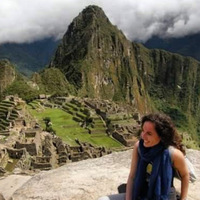- Post Disaster Reconstruction, Digital Archaeology, Natural Disasters, Environmental Archaeology, Humanitarian Assistance and Disaster Relief, Medical Humanities, and 8 moreHealth Humanities, Pedagogy, Neuroscience and Architecture, Public Archaeology, Bioarchaeology, Hospital Architecture, Gender Studies, and Human remains in Archaeologyedit
- Historian of art and architecture, researcher in the field of medical and health humanities, cultural heritage management and public archaeologyedit
In the first quarter of the twentieth century, health and hygiene-themed exhibitions and museums became prevalent communication tools for public health throughout the world. However, the primary motivation behind their establishment as... more
In the first quarter of the twentieth century, health and hygiene-themed exhibitions and museums became prevalent communication tools for public health throughout the world. However, the primary motivation behind their establishment as medical museums was the educational value they added to medical training. These museums became central to instruction at medical schools in the nineteenth century. This article presents an overview of the origins of museums of medicine, health and hygiene, their role in the Ottoman/Turkish context, and how they gained and lost their prominence. It then proposes ways in which these museums can be instrumental in our fight against infectious diseases and social injustices in the field of biomedicine. Keywords: medical museum, Hikmet Hamdi, hygiene exhibit, Sıhhi Müze, public health communication, science communication, critical medical humanities, health humanities
Research Interests:
Research Interests:
Tez (Yüksek Lisans) -- İstanbul Teknik Üniversitesi, Sosyal Bilimler Enstitüsü, 2018Thesis (M.A.) -- İstanbul Technical University, Institute of Social Sciences, 2018Bu çalışma, Osmanlı İmparatorluğu'nda Tanzimat Fermanı (1839) ile... more
Tez (Yüksek Lisans) -- İstanbul Teknik Üniversitesi, Sosyal Bilimler Enstitüsü, 2018Thesis (M.A.) -- İstanbul Technical University, Institute of Social Sciences, 2018Bu çalışma, Osmanlı İmparatorluğu'nda Tanzimat Fermanı (1839) ile başlayan ve II. Meşrutiyet Dönemi (1908-1918) boyunca devam eden Batılılaşma girişimlerinin Osmanlı İmparatorluğu'nu kadının özgürleşmesi bağlamında 'modernleşme' hedefine ulaştırıp ulaştırmadığını sorgulamaktadır. Çalışma, 19. yüzyıl boyunca ve 20. yüzyıl başında uygulanan eğitim reformlarının detaylı bir dökümünü sunarken Osmanlı sanat zevki ve üretiminin de Batı etkisi altında geçirdiği evrimin eleştirel bir çözümlemesini yapmaktadır. Kadın, eğitim ve güzel sanatların kesişim noktasında bulunan İnas Sanayi-i Nefise Mekteb-i Âlisi'nin örnek kurum olarak karşılaştırmalı ve ontolojik tahlilini yapılmaktadır. Çalışmanın amacı okula güncel literatürde bahşedilen yüksek nitelikleri yapısöküme uğratarak tartışmayı Osmanlı kadın tarihinin p...
Research Interests:
The spread of infectious diseases claimed more lives than battle wounds during the Crimean War (1853-1856). Istanbul, then the Ottoman capital, was transformed into a medical hub where new ideas were tested and exchanged among doctors and... more
The spread of infectious diseases claimed more lives than battle wounds during the Crimean
War (1853-1856). Istanbul, then the Ottoman capital, was transformed into a medical hub
where new ideas were tested and exchanged among doctors and nurses from all over Europe
to control the spread of disease. Although the most well-known figure of this international
effort was Florence Nightingale, the medical community serving in Istanbul at the time
had many other heroes and heroines. While Nightingale’s work played an important role in
shaping healthcare facilities in the second half of the 19th century, there were other factors
at play that lead to this transformation. Notably, the Crimean War was the first major armed
conflict that was directly reported from the front by newspaper reporters as it was happening;
a possible catalyst for the significant improvements in hospital conditions that Post-Crimean
War Europe witnessed. Most of these improvements were measures that had already been
proposed prior to the Crimean War. Pavilion style typology in hospital architecture was one
such measure dating back to the first quarter of the 18th century. This article attempts to
question the changing attitudes in Europe towards healthcare facilities immediately after the
Crimean War and questions their links to political aspirations of the time.
War (1853-1856). Istanbul, then the Ottoman capital, was transformed into a medical hub
where new ideas were tested and exchanged among doctors and nurses from all over Europe
to control the spread of disease. Although the most well-known figure of this international
effort was Florence Nightingale, the medical community serving in Istanbul at the time
had many other heroes and heroines. While Nightingale’s work played an important role in
shaping healthcare facilities in the second half of the 19th century, there were other factors
at play that lead to this transformation. Notably, the Crimean War was the first major armed
conflict that was directly reported from the front by newspaper reporters as it was happening;
a possible catalyst for the significant improvements in hospital conditions that Post-Crimean
War Europe witnessed. Most of these improvements were measures that had already been
proposed prior to the Crimean War. Pavilion style typology in hospital architecture was one
such measure dating back to the first quarter of the 18th century. This article attempts to
question the changing attitudes in Europe towards healthcare facilities immediately after the
Crimean War and questions their links to political aspirations of the time.
